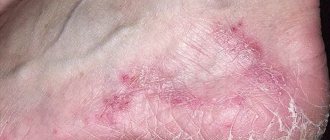Osgood-Schlatter disease, also known as osteochondropathy of the tuberous surface of the tibia, is not a rare pathology in medical practice. The category of osteochondropathy includes many different pathologies, most of which affect the tubular bones to which the components of the tendon-ligamentous apparatus and adjacent tissues are attached.
Adults rarely suffer from diseases from the category of osteochondropathy. Most often they affect patients of preschool age and adolescence.
What it is?
Schlatter's disease was described in 1906 by Osgood-Schlatter, whose name it bears.
Another name for the disease, which is also used in clinical orthopedics and traumatology, reflects the essence of the processes occurring in Schlatter’s disease and sounds like “osteochondropathy of the tibial tuberosity.” From this name it is clear that Schlatter's disease, like Calve's disease, Thiemann's disease and Köhler's disease, belongs to the group of osteochondropathy - diseases of non-inflammatory origin, accompanied by necrosis of bone tissue. Schlatter's disease is observed during the period of most intensive bone growth in children from 10 to 18 years old, much more often in boys.
The disease can occur with damage to only one limb, but Schlatter's disease with a pathological process in both legs is quite common.
Forecast
As a rule, the symptoms of the disease subside within two years, and the prognosis is favorable in most cases. In summary, symptoms of Osgood-Schlatter disease are reduced and completely resolved in most patients if conservative treatments are used long enough, especially after bone growth stops (Evidence Level: IIIb).
Persistent symptoms are accompanied by the growth of a free bone fragment above the LCL or within the patellar ligament. In these cases, only surgical treatment will relieve symptoms (level of evidence: IV).
It is important to convince the patient that his condition is temporary.
Reasons for development
Osteochondropathy of the tibia develops at a young age, from 10 to 18 years, in individuals who engage in intensive and regular sports. Since boys are traditionally more active, the disease is diagnosed in them several times more often. Schlatter's disease does not occur in adults.
It should be noted that the disease affects adolescents regardless of their general health, so even completely healthy people get sick. Increased risk factors are sports training associated with high stress on the knees - football, volleyball, handball, weightlifting and athletics, martial arts and skiing. For girls, ballet, dancing, gymnastics and tennis are considered traumatic.
There is also a relationship between the age of a teenager and the manifestation of the disease - girls get sick earlier than boys. This is due to the timing of puberty, which provokes intensive growth. For girls it is 11-12 years old, and for boys it is 13-14.
The main cause of the disease is not a one-time injury - a bruise or a fall, but chronic trauma associated with sudden movements, frequent turns of the knees and jumps. The tubular bones of young people contain so-called “growth zones” - epiphyseal plates consisting of cartilage tissue. Their strength is much lower than that of bones, which makes the growth zones vulnerable to various damage.
Under the influence of constant overload, the tendons can overstretch and tear, as a result of which the knees begin to hurt and swell, and blood circulation in the area of the tibia tuberosity is disrupted. Inflammation develops in the knee joint itself, which is manifested by periodic hemorrhages.
As a result of damage to the cartilage, necrotic changes gradually appear on the tuberosity of the bone, which the growing body tries to fill with bone tissue. Because of this, a pineal formation appears, which is a bone growth.
Epidemiology. Etiology
In children and adolescents, there are growth plates in both the femur and tibia (endochondral bone/cartilage in the LBD area). This cartilage (flexible connective tissue that is often located between two bones), like bones, muscles and tendons, has the ability to grow. But during the growth spurt of adolescence, bones and cartilage grow much faster than muscles and tendons.
Slower lengthening of the quadriceps femoris muscle, which is the musculotendinous extensor apparatus of the knee joint, results in excessive tension where the patellar tendon attaches to the LCL. Because of this, microavulsions (microtears) of this zone may occur.
Tuberosity cartilage (the anterior part of the developing center of ossification of the LCL) can cope with the loads placed on it, but not in the same way as bone. Therefore, when a child or adolescent exercises, the stress on the patellar tendon and LBD increases, causing pain, irritation and, in some cases, microavulsions or avulsion fractures.
Increased tension at the musculotendinous junction of the patellar tendon and the ankle joint can cause the tendon to slightly pull away from the bone. Which, in turn, will increase the pain and cause swelling below the kneecap. This condition will be aggravated by activities that place greater stress on the patellar tendon, such as squats or jumping. In some cases, ossification may occur in the area of injury, which will lead to the appearance of a bony protrusion in the LBD area.
Symptoms
Symptoms of Osgood-Schlatter disease most often occur in adolescents 10-18 years old, not only after a bruise, fall or physical exertion, but also without any external influence, pain begins with strong extension or extreme flexion of the knee, limited, dense, sharply painful pain develops. pressure causes swelling of the tibial tubercle.
The general condition is satisfactory, local inflammatory changes are absent or mild. The pathological process is usually self-limiting. Its occurrence is caused by the load on the patellar ligament, which is attached to the tibial tuberosity. Against the background of accelerated growth in adolescence, repeated loads on the ligament and immaturity of the tibial tuberosity can provoke a subacute fracture of the latter in combination with ligamentitis of the patellar ligament. These changes lead to the formation of pathological bone growths that are painful with sudden movements. When leaning on the knee, pain can radiate along the ligament and above the patella into the quadriceps femoris tendon, which is attached to the upper edge of the patella. The general condition is satisfactory, local inflammatory changes are absent or mild.
Often, after one, the other knee also becomes ill, with the same objective changes in the lower leg. Soreness and pain last for months, worsening under the influence of mechanical strokes, gradually disappearing over the course of a year, rarely later. The prognosis is quite favorable. The bony protrusion remains, but without any damage to the function of the knee. Histologically, the process is characterized by thickening of the cartilaginous layer between the tibial metaphysis and the patellar ligament, irregular boundaries of the ossification zones, extending into the tendon tissue and forming cell-rich fibrous cartilage, sometimes with a mucous-type ground substance.
Anatomy
The tibial tubercle (TT) is a large, elongated projection on the superior anterior border of the tibia, which is located slightly distal to the anterior surfaces of the medial and lateral tibial condyles. This area is the site of attachment of the patellar ligament. Tension in this muscle-tendon junction can cause pain and swelling. Mostly the pain occurs on one side, but often occurs on both sides.
Thus, Osgood-Schlatter disease is characterized by damage to the tibial tuberosity area and pain in the anterior knee joint .
Diagnostics
Schlatter's disease can be diagnosed by a combination of clinical signs and typical localization of pathological changes. The age and gender of the patient are also taken into account. However, the decisive factor in making a diagnosis is an X-ray examination, which should be carried out over time for greater information. X-rays of the knee joint are performed in direct and lateral projections.
In some cases, an ultrasound of the knee joint, MRI and CT of the joint are additionally performed. Densitometry is also used to obtain data on the structure of bone tissue. Laboratory diagnostics are prescribed to exclude the infectious nature of damage to the knee joint (specific and nonspecific arthritis). It includes a clinical blood test, a blood test for C-reactive protein and rheumatoid factor, and PCR studies.
In the initial period, Schlatter's disease is characterized by a radiographic picture of flattening of the soft cover of the tibial tuberosity and raising of the lower border of the clearing, corresponding to the adipose tissue located in the anterior part of the knee joint. The latter is due to an increase in the volume of the subpatellar bursa as a result of its aseptic inflammation. There are no changes in the nuclei (or nucleus) of ossification of the tibial tuberosity at the onset of Schlatter's disease.
Over time, radiologically, a displacement of the ossification nuclei forward and upward by 2 to 5 mm is noted. The trabecular structure of the nuclei may be blurred and their contours uneven. Gradual resorption of displaced nuclei is possible. But more often they merge with the main part of the ossification nucleus to form a bone conglomerate, the base of which is the tibial tuberosity, and the apex is a spine-like protrusion, clearly visualized on a lateral radiograph and palpated in the area of the tuberosity.
Differential diagnosis of Schlatter's disease must be carried out with a fracture of the tibia, syphilis, tuberculosis, osteomyelitis, and tumor processes.
Carrying out an inspection
The diagnosis can be made based on the collected medical history and objective examination . Tenderness of the LBD area upon palpation, which intensifies during squats with weights or jumping, is a fairly characteristic symptom of Osgood-Schlatter disease.
Extending the knee bent at a right angle, during which the patient must overcome resistance, reproduces pain. At the same time, no pain occurs during the straight leg lift through resistance.
The Duncan-Ely test (Ely's test or Duncan-Ely) , which detects excessive tension in the quadriceps femoris muscle, will be positive in all cases.
Complications
Osgood-Schlatter disease rarely causes complications. In some cases, local swelling or chronic pain may remain in the knee area. As a rule, they occur after physical exertion and respond well to treatment with non-steroidal anti-inflammatory drugs and physiotherapy.
After treatment, a bone growth may remain in the lower leg area. It usually does not affect the mobility of the knee in any way and does not cause discomfort in everyday life or during sports training.
In severe cases of Osgood-Schlatter disease, a bone growth can cause displacement and deformation of the patella. In such patients, after bone growth stops, osteoarthritis develops and constant pain will be felt when trying to kneel. In some patients, against the background of such changes, pain occurs only when the weather changes.
In the most severe cases, Osgood-Schlatter disease results in severe bone destruction that cannot be controlled with conservative treatments. In such cases, there is a need for surgical intervention aimed at removing the entire area of the joint affected by the destructive process. “Dead” parts of the articular structures in such cases are replaced with grafts.
Clinical picture
The leading symptom of this disease is pain, which appears and intensifies during physical activity - running, jumping, cycling, kneeling, going up and down stairs, and hitting a ball (in the phase when the knee extends). Most often, pain intensifies when playing sports such as basketball, volleyball, football and tennis. Clinically, the disease manifests itself as pain localized in the LBD area. In some cases, there may be swelling and hypertrophy, as well as excessive tension in the quadriceps femoris muscle. Characteristics such as local fever and intra-articular edema are not important in this disease. There is rarely hyperthermia in this area, but swelling, tenderness and pain often occur.
Clinical symptoms include the following:
- pain on palpation of the LBD;
- pain in the tuberosity area, which intensifies after physical activity or sports;
- increasing pain when squatting, walking up stairs or jumping.
Treatment
As a rule, the pathology responds well to treatment and has a favorable prognosis, but the main problem is the duration of therapy (from 6 months to 2 years) and the need to follow recommendations on the physical activity regimen.
Treatment of Osgood Schlatter disease in adolescents can be conservative or surgical.
Conservative therapy
This is the main type of treatment for this problem. The main goal of therapy is to relieve pain, reduce the intensity of aseptic inflammation and ensure the normal process of ossification of the tibial tuberosity.
The main method of conservative therapy is a gentle regimen of physical activity. During treatment, you must stop all sports and other excessive physical activity. It is mandatory to use various orthopedic products to protect the knee joint - orthoses, bandages, elastic bandages, clamps, patellar bandages.
In complex therapy, drug correction is also prescribed. In case of pain, analgesics and non-steroidal anti-inflammatory drugs are prescribed in appropriate age-appropriate doses. All patients are also prescribed calcium supplements and multivitamins. Physiotherapy is a mandatory component of conservative therapy.
Patients are prescribed courses:
- UHF,
- magnetic therapy,
- phonophoresis,
- electrophoresis,
- laser therapy,
- shock wave therapy.
Also, all patients are prescribed therapeutic exercises and massage courses.
As a rule, such complex treatment brings positive results after 3-6 months, but sometimes therapy can take longer. In cases where conservative therapy is ineffective, and the disease progresses, its complications develop, and surgical intervention is resorted to.
Surgery
Indications for surgery in patients with Osgood-Schlatter disease are:
- long-term course of pathology and ineffectiveness of conservative therapy (when the course of treatment lasts more than 2 years);
- the presence of persistent pain that is not eliminated by other treatment methods;
- if, using radiography, fragmentation of the tibial tuberosity is observed and separation of individual bone fragments is observed;
- if the child’s age at the time of diagnosis of the disease is 14 years or older.
The operation itself is considered technically uncomplicated. The surgeon removes all separated bone fragments and performs tendon and ligament reconstruction.
Rehabilitation after surgical treatment is not long. After a course of conservative treatment, the child will again be able to lead an active lifestyle and completely get rid of the disease.
Activity Limit
Conservative treatment for this condition is based on the same principles that apply to all overuse injuries.
The modern approach to the treatment of Osgood-Schlatter disease does not require complete immobilization of the patient, nor does it require a total refusal of sports activities. It is of great importance that the doctor inform the parents, coach and child about the natural course of the disease.
The child should continue his usual activities to the extent that pain allows. Therefore, the intensity and frequency of exercise should be reduced (that is, adapted to the specific patient). As an addition to the main activities, swimming can be recommended, which usually does not cause discomfort.
Knee pads, tape, or elastic knee supports with an infrapatellar strap or pad may also be recommended. They may help with exercise and reduce pain (Evidence Level: V).
A study by Gerulis et al. (level of evidence: IIb) showed that limiting physical activity, adapting it to the patient's capabilities and conservative treatment together have a more powerful effect than simply reducing exercise without conservative therapy.
Prevention
After eliminating all irritating factors, resting the injured knee and conducting a complex of moderate therapy, the patient must continue to take precautions.
To prevent Osgood-Schlatter disease in adolescents in the future, you need to relieve the joint and avoid provocateurs of the disease (jumping, running, kneeling). You can replace your usual sports with more loyal ones (swimming, cycling), although, as a rule, after treatment, restrictions on playing sports are lifted.
Preventive measures are not always a guarantee that the disease will not manifest itself again. Any microtrauma can develop into Osgood-Schlatter disease if it is not noticed in time and treatment is not started. Children and adolescents are always at risk, whose constant activities (dancing, sports) carry the risk of injury to the lower extremities. For professional athletes, daily foot care should become a habitual ritual. This is the only way to maintain healthy feet and avoid osteochondropathy.
Arthrosis of the knee joint Arthrosis of the knee joint Osteoporosis - what is it and how to treat it? Hepatitis C: first signs and treatment regimen Glaucoma Alzheimer's disease
Predisposing factors
As already mentioned, Osgood-Schlatter disease develops mainly in children and adolescents. Much more often, pathology is observed in children who actively engage in sports. Osteochondropathy occurs more often in boys than in girls.
Children who play sports are at risk of developing Osgood-Schlatter disease
The main peak incidence is observed in children 11-14 years old. The disease is quite common and occurs in approximately 13% of all children who actively engage in sports. It is also important to note that among these adolescents the disease debuts precisely after an episode of some kind of trauma, often not at all severe.
Among the main risk factors for pathology are the following:
- Age. The disease occurs mainly in childhood; in adult patients, residual manifestations in the form of a tubercle under the knee can only be observed.
- Floor. Males are more likely to get sick, but every year the gender differences are decreasing, as girls today begin to engage in similar sports along with boys.
- Physical exercise. Osgood-Schlatter disease is 5 times more likely to affect people who participate in active sports.










